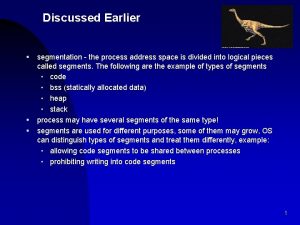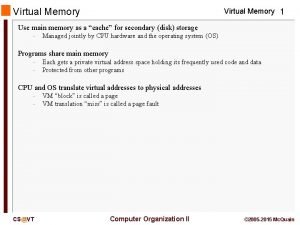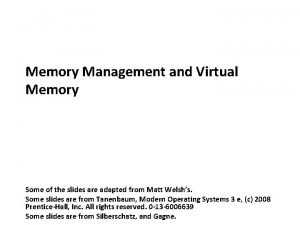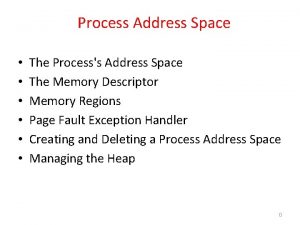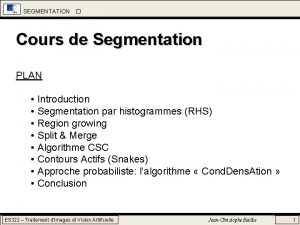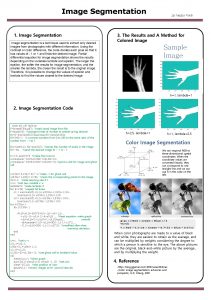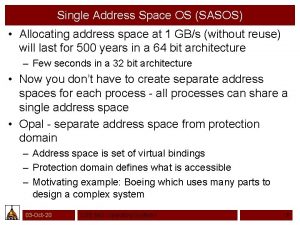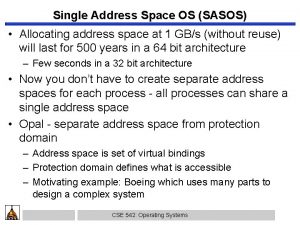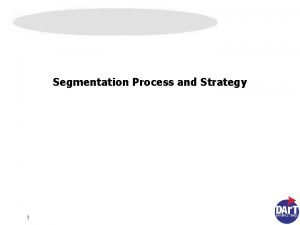Discussed Earlier segmentation the process address space is













- Slides: 13

Discussed Earlier § § § segmentation - the process address space is divided into logical pieces called segments. The following are the example of types of segments • code • bss (statically allocated data) • heap • stack process may have several segments of the same type! segments are used for different purposes, some of them may grow, OS can distinguish types of segments and treat them differently, example: • allowing code segments to be shared between processes • prohibiting writing into code segments 1

Paging (Outline) § § § definition page table description memory protection and sharing TLBs page table organization • multilevel • hashed • inverted memory management organization example: Pentium/Linux 2

Paging Definition § § § each process is divided into a number of small, fixed-size partitions called pages physical memory is divided into a large number of small, fixed-size partitions called frames page size = frame size • usually 512 bytes to 16 K bytes (lately tends to be 4 K) the whole process is still loaded into memory, but the pages of a process do not have to be loaded into a contiguous set of frames virtual (logical) address consists of page number and offset from beginning of the page 3

Page Table § § § page table – per process data structure that provides mapping from page to frame address space the set of all possible addresses logical address space – continuous physical address space – fragmented to obtain physical memory address the page number part of it is translated to frame number 4

Protection in Page Tables § § § process may not use the whole page table unused portions of the page table are protected by valid/invalid bit the address space for the process is 0 through 12, 287 (6 - 2 K pages) even though the page table contains additional unused page references they are marked as invalid attempt to address these pages will result in a trap with “memory protection violation” alternatively page-table base register (PTBR) points to the page table page-table length register (PRLR) indicates size of the page table 5

Sharing Pages § § paging provides easy way of reusing the code if multiple processes are executing the same program (ex: text editor) the pages containing the code for the editor can be shared the code has to be reentrant (not self-modifying) and write protected – usually every page has a read-only bit how can shared memory be implemented using the same technique? 6

TLBs § § § page table resides in memory; getting data/code requires more than one memory lookup solution: translation lookaside buffers (TLB) – associative cache that holds page and frame numbers on page access, page # is first looked in TLBs if found (cache hit) can immediately access page if not found (cache miss) have to look up the frame in the page table program with good code locality of reference benefits from TLBs what happens on context switch? old way: flush TLBs (destroying all info they hold) new way: each TLB entry stores address-space identifier (ASID) – identifies process, if wrong process – cache miss 7

Multilevel Page Table § § address space of modern computer system is 232 to 264 size of page table is potentially large • ex: 232 address space 4 K pages (212), 4 -byte page entry – 1 M page entries, 4 MB of space how to search? trivial if allocation is continuous (such allocation is difficult with large page sizes) page the page table (multilevel page table) may have up to three levels 8

Hashed Page Table § § § multilevel page table potentially requires multiple memory lookups for single memory access inefficient for large address spaces (264) hashed page table – hashes logical page number. In case of hash collision, page references are linked 9

Inverted Page Table § § § § (direct) page table may itself consume significant amount of memory • may be inefficient especially for architectures with large virtual address space (64 -bit) instead, store one (global) page table for all processes one entry for each frame search table to find the frame that logical page refers to need to keep PID to know if page access is from correct process linear search inefficient use additional hash table difficulty implementing shared pages • why? 10

Intel Pentium Segmentation § § § § supports both segmentation and paging MMU consist of segmentation and paging units CPU produces logical address segmentation unit translates it into linear address paging unit provides physical address two descriptor (segment) tables • local (LDT) – specific to process • global (GDT) – shared among processes each entry in descriptor table contains segment base/limit/protection info CPU has specialized registers to hold descriptor info – if stored on registers, no memory access needed 11

Intel Pentium Paging § § paging unit translates from linear to physical address supports 4 KB and 4 MB pages 4 KB pages • linear address consists of 20 -bit page number and 12 -bit page offset • two level page table F page directory – outer table, higher 10 bits of page number F page table – inner table, lower 10 bits of page number 4 MB pages • only page directory is used higher 10 bits • lower 22 bits – page offset 12

Memory Management in Linux § § Linux – OS designed to be portable across architectures • does not use some of Pentium specifics uses only six segments • in GDT – kernel code, kernel data, user code, user data F note that user code and data are in GDT – protection is designed on page-level • in LDT – task state segment (TSS), default segment – effectively PCB uses only two protection modes – user and kernel (Pentium supports four) uses three-level page table (to accommodate 64 -bit architectures) • on Pentium the size of middle directory is 0 13
 As discussed earlier meaning
As discussed earlier meaning Virtual address space
Virtual address space Virtual memory
Virtual memory Shared pages
Shared pages Virtual memory linux
Virtual memory linux Segmented paging
Segmented paging Memory swaping
Memory swaping Current and future trends of media and information essay
Current and future trends of media and information essay As discussed
As discussed Kant first categorical imperative
Kant first categorical imperative How did the person named in this 1909 handbill
How did the person named in this 1909 handbill Which of these is not a force discussed in this chapter?
Which of these is not a force discussed in this chapter? The paragraph preceding the passage most probably discusses
The paragraph preceding the passage most probably discusses Lets have a recap
Lets have a recap
